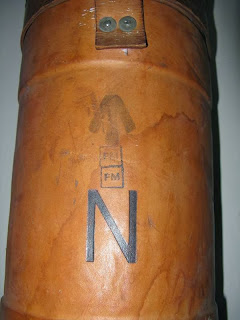Having finished restoring our cordite bucket I am sure some people are saying. " Great, it looks good but what is it? ". We have sold a few over the years and as we will need to research it for its description in our forthcoming catalogue I thought this might be a good place to to expand on that.
The first thing to know is it is not a bucket made of cordite but a bucket made to carry cordite. They are also referred to as Clarkson cases. From the Naval weapons website a definition "British propellant charge container. These were flash proof containers for bag charges (cartridges). Charges were placed into these containers before they left the magazines. The Clarkson's Cases then rode up the hoists to the guns where the charges were removed only when it was time to load them into the breech. The Clarkson's Cases were reusable and were returned to the magazines for reloading."
Which leads on to the first question. What is cordite? This entry from wikipedia is a good start.
" Cordite is a family of smokeless propellants developed and produced in the United Kingdom from 1889 to replace gunpowder as a military propellant. Like gunpowder, cordite is classified as a low explosive because of its slow burning rates and consequently low brisance. These produce a subsonic deflagration wave rather than the supersonic detonation wave produced by brisants, or high explosives. The hot gases produced by burning gunpowder or cordite generate sufficient pressure to propel a bullet or shell to its target, but not so quickly as to routinely destroy the barrel of the firearm, or gun. Cordite was used initially in the .303 British, Mark I and II, standard rifle cartridge between 1891 and 1915; shortages of cordite in World War I led to United States–developed smokeless powders being imported into the UK for use in rifle cartridges. Cordite was also used for large weapons, such as tank guns, artillery and naval guns. It has been used mainly for this purpose since the late 19th century by the UK and British Commonwealth countries." So the name comes from it being constructed in "cords". This photo shows what the cordite looks like.
That probably helps explain the construction of the buckets. Its use dictates its construction. The body is made out of cork covered on the inside in canvas and the outside in leather. The handles and straps which are sewn are fixed to the body using copper rivets. So why these materials ? Basically they are "fit for purpose."
Cork is naturally fire resistant which is well suited to the safety angle of what is being contained and its light weight will be a bonus in making it easier to move around.
The leather is use to cover the cork as the hide can be wet , stretched and glued on meaning it will shrink on drying giving a tidy, tight finish. We have seen others which have painted canvas on the out side either have lost their leather and have been painted or possibly could be a different type.
The canvas is purely used on the inside to seal the cork and on the outside to do this but also to provide a good surface to glue the leather on to.
Copper rivets and the plate supporting the handle on the inside provide a strong fitting and are used because the metal will not give a potentially lethal spark. The cordite cases would be used to transport the charge from the magazine to the guns.
So what do the marking's mean. Lets look at this example:
 |
Firstly the "broad arrow" mark. This was used to show they were the property of the Board of Ordnance or Government department. This link gives some more history on the mark. If you see 2 broad arrow marks facing each other this is a sign that the case was decommissioned. N for Navy. B.H.&G. Ltd shows it was made by Barrow, Hepburn & Gale of Bermondsey, London. No 72 could be a size number and the I its mark. See diagram below. Possibly, all the cordite buckets were numbered and may even have corresponded with a specific gun? Hopefully, some information will come to light and I can update this blog. Some will be stamped 'RCD' for Royal Chatham Dockyard. This book the Handbook of Ammunition from 1945 gives alot of answers and has this image showing cordite buckets.
The BL refers to breech loading guns. As you would expect no signs of a stenciled armorial which I am sure were added later when they were decommissioned and sold off as umbrella stands and waste paper bins. Some of the taller ones we have seen reduced in height to do this. Some examples with stencils:
|
|
By Simon Clarke
References
Tony DiGiulian "Ammunition , Fuzes, Projectiles and Propellants" www.navweaps.com
BR932 Handbook on Ammunition 1945.
British Ordnance Collectors Network http://www.bocn.co.uk
Christies
1stDibs.
www.campaignfurniture.com






